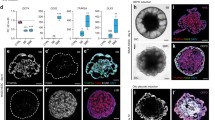Abstract
The sensory epithelia of the inner ear contain mechanosensitive hair cells that detect sound and head acceleration. This protocol details a 3D differentiation method to generate inner ear organoids containing sensory epithelia with hair cells. Human pluripotent stem cells are aggregated in low-binding 96-well plates and treated in chemically defined media with extracellular matrix to promote epithelialization. Small molecules and recombinant proteins are applied in a stepwise manner to recapitulate the morphogenic cues (BMP, TGF-β, FGF, and WNT) present during inner ear development in vivo. These treatments induce the sequential formation of nonneural ectoderm, otic-epibranchial progenitor domain, and otic placodes. The derived otic placodes then undergo self-guided morphogenesis to form otic vesicles, which eventually give rise to sensory epithelia containing hair cells and supporting cells, as well as neurons with synaptic formations to hair cells. This human stem cell–derived inner ear organoid system provides an ideal platform to study human inner ear development and disease in vitro.
Access this chapter
Tax calculation will be finalised at checkout
Purchases are for personal use only
Similar content being viewed by others
References
Geleoc GS, Holt JR (2014) Sound strategies for hearing restoration. Science 344(6184):1241062. https://doi.org/10.1126/science.1241062
Muller U, Barr-Gillespie PG (2015) New treatment options for hearing loss. Nat Rev Drug Discov 14(5):346–365. https://doi.org/10.1038/nrd4533
Barth KA, Kishimoto Y, Rohr KB, Seydler C, Schulte-Merker S, Wilson SW (1999) Bmp activity establishes a gradient of positional information throughout the entire neural plate. Development 126(22):4977–4987
Grocott T, Tambalo M, Streit A (2012) The peripheral sensory nervous system in the vertebrate head: a gene regulatory perspective. Dev Biol 370(1):3–23. https://doi.org/10.1016/j.ydbio.2012.06.028
Harvey NT, Hughes JN, Lonic A, Yap C, Long C, Rathjen PD, Rathjen J (2010) Response to BMP4 signalling during ES cell differentiation defines intermediates of the ectoderm lineage. J Cell Sci 123(Pt 10):1796–1804. https://doi.org/10.1242/jcs.047530
Wilson PA, Hemmati-Brivanlou A (1995) Induction of epidermis and inhibition of neural fate by Bmp-4. Nature 376(6538):331–333. https://doi.org/10.1038/376331a0
Ahrens K, Schlosser G (2005) Tissues and signals involved in the induction of placodal Six1 expression in Xenopus laevis. Dev Biol 288(1):40–59. https://doi.org/10.1016/j.ydbio.2005.07.022
Kwon HJ, Bhat N, Sweet EM, Cornell RA, Riley BB (2010) Identification of early requirements for preplacodal ectoderm and sensory organ development. PLoS Genet 6(9):e1001133. https://doi.org/10.1371/journal.pgen.1001133
Litsiou A, Hanson S, Streit A (2005) A balance of FGF, BMP and WNT signalling positions the future placode territory in the head. Development 132(18):4051–4062. https://doi.org/10.1242/dev.01964
Pieper M, Ahrens K, Rink E, Peter A, Schlosser G (2012) Differential distribution of competence for panplacodal and neural crest induction to non-neural and neural ectoderm. Development 139(6):1175–1187. https://doi.org/10.1242/dev.074468
Reichert S, Randall RA, Hill CS (2013) A BMP regulatory network controls ectodermal cell fate decisions at the neural plate border. Development 140(21):4435–4444. https://doi.org/10.1242/dev.098707
Freter S, Muta Y, Mak SS, Rinkwitz S, Ladher RK (2008) Progressive restriction of otic fate: the role of FGF and Wnt in resolving inner ear potential. Development 135(20):3415–3424. https://doi.org/10.1242/dev.026674
Groves AK, Fekete DM (2012) Shaping sound in space: the regulation of inner ear patterning. Development 139(2):245–257. https://doi.org/10.1242/dev.067074
Munnamalai V, Fekete DM (2013) Wnt signaling during cochlear development. Semin Cell Dev Biol 24(5):480–489. https://doi.org/10.1016/j.semcdb.2013.03.008
Sai X, Ladher RK (2015) Early steps in inner ear development: induction and morphogenesis of the otic placode. Front Pharmacol 6:19. https://doi.org/10.3389/fphar.2015.00019
Sun S, Babola T, Pregernig G, So KS, Nguyen M, Su SM, Palermo AT, Bergles DE, Burns JC, Muller U (2018) Hair cell Mechanotransduction regulates spontaneous activity and spiral ganglion subtype specification in the auditory system. Cell 174(5):1247–1263. e1215. https://doi.org/10.1016/j.cell.2018.07.008
Yamashita T, Zheng F, Finkelstein D, Kellard Z, Carter R, Rosencrance CD, Sugino K, Easton J, Gawad C, Zuo J (2018) High-resolution transcriptional dissection of in vivo Atoh1-mediated hair cell conversion in mature cochleae identifies Isl1 as a co-reprogramming factor. PLoS Genet 14(7):e1007552. https://doi.org/10.1371/journal.pgen.1007552
DeJonge RE, Liu XP, Deig CR, Heller S, Koehler KR, Hashino E (2016) Modulation of Wnt signaling enhances inner ear organoid development in 3D culture. PLoS One 11(9):e0162508. https://doi.org/10.1371/journal.pone.0162508
Koehler KR, Hashino E (2014) 3D mouse embryonic stem cell culture for generating inner ear organoids. Nat Protoc 9(6):1229–1244. https://doi.org/10.1038/nprot.2014.100
Longworth-Mills E, Koehler KR, Hashino E (2016) Generating inner ear organoids from mouse embryonic stem cells. Methods Mol Biol 1341:391–406. https://doi.org/10.1007/7651_2015_215
Nie J, Koehler KR, Hashino E (2017) Directed differentiation of mouse embryonic stem cells into inner ear sensory epithelia in 3D culture. Methods Mol Biol 1597:67–83. https://doi.org/10.1007/978-1-4939-6949-4_6
Koehler KR, Nie J, Longworth-Mills E, Liu XP, Lee J, Holt JR, Hashino E (2017) Generation of inner ear organoids containing functional hair cells from human pluripotent stem cells. Nat Biotechnol 35(6):583–589. https://doi.org/10.1038/nbt.3840
Liu XP, Koehler KR, Mikosz AM, Hashino E, Holt JR (2016) Functional development of mechanosensitive hair cells in stem cell-derived organoids parallels native vestibular hair cells. Nat Commun 7:11508. https://doi.org/10.1038/ncomms11508
Acknowledgments
We would like to thank Jing Nie for the protocol optimization. This work was supported by a National Institutes of Health grant R01 DC015788 and a Department of Defense U.S. Army Medical Research and Materiel Command Congressionally Directed Medical Research Program grant W81XWH-18-1-0062 (to E.H.).
Author information
Authors and Affiliations
Corresponding author
Editor information
Editors and Affiliations
Rights and permissions
Copyright information
© 2021 Springer Science+Business Media, LLC
About this protocol
Cite this protocol
Ueda, Y., Moore, S.T., Hashino, E. (2021). Directed Differentiation of Human Pluripotent Stem Cells into Inner Ear Organoids. In: Turksen, K. (eds) Embryonic Stem Cell Protocols . Methods in Molecular Biology, vol 2520. Humana, New York, NY. https://doi.org/10.1007/7651_2021_448
Download citation
DOI: https://doi.org/10.1007/7651_2021_448
Published:
Publisher Name: Humana, New York, NY
Print ISBN: 978-1-0716-2436-4
Online ISBN: 978-1-0716-2437-1
eBook Packages: Springer Protocols




